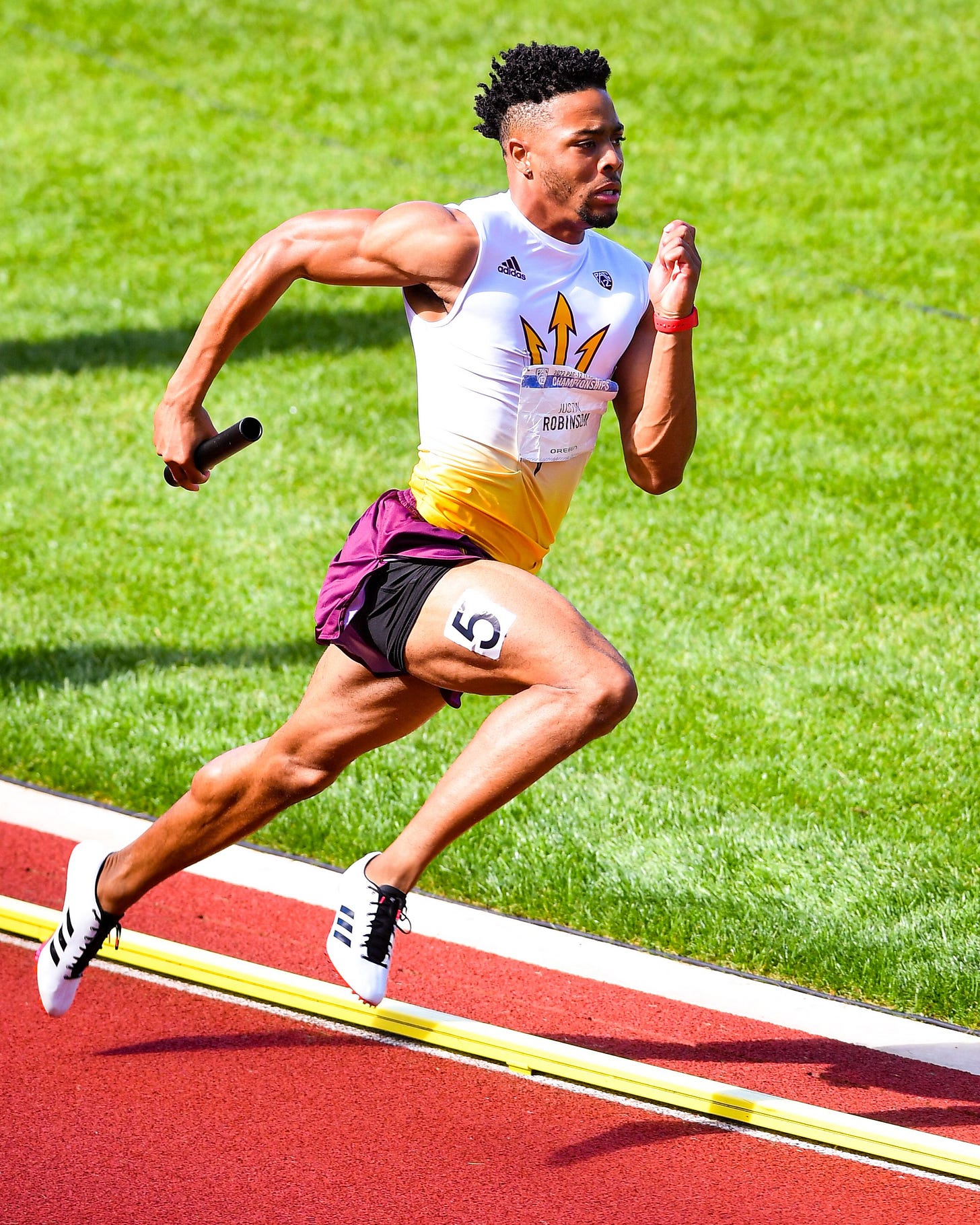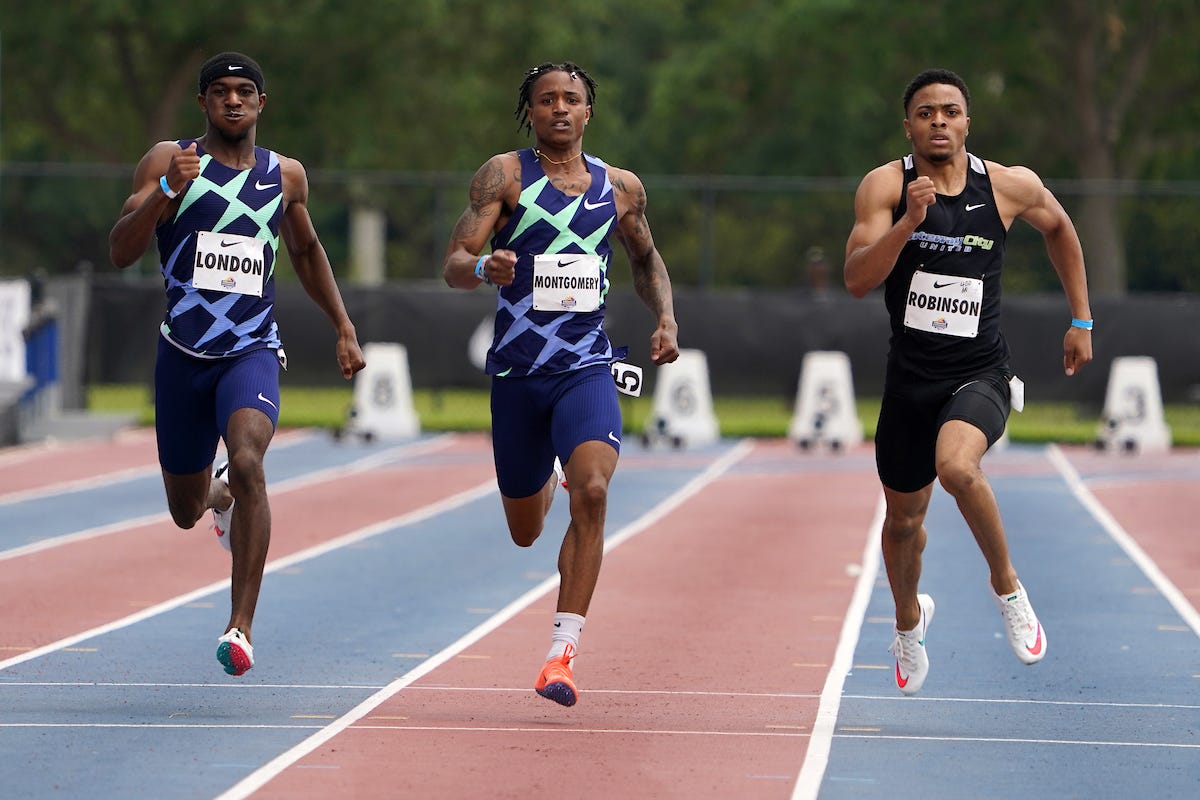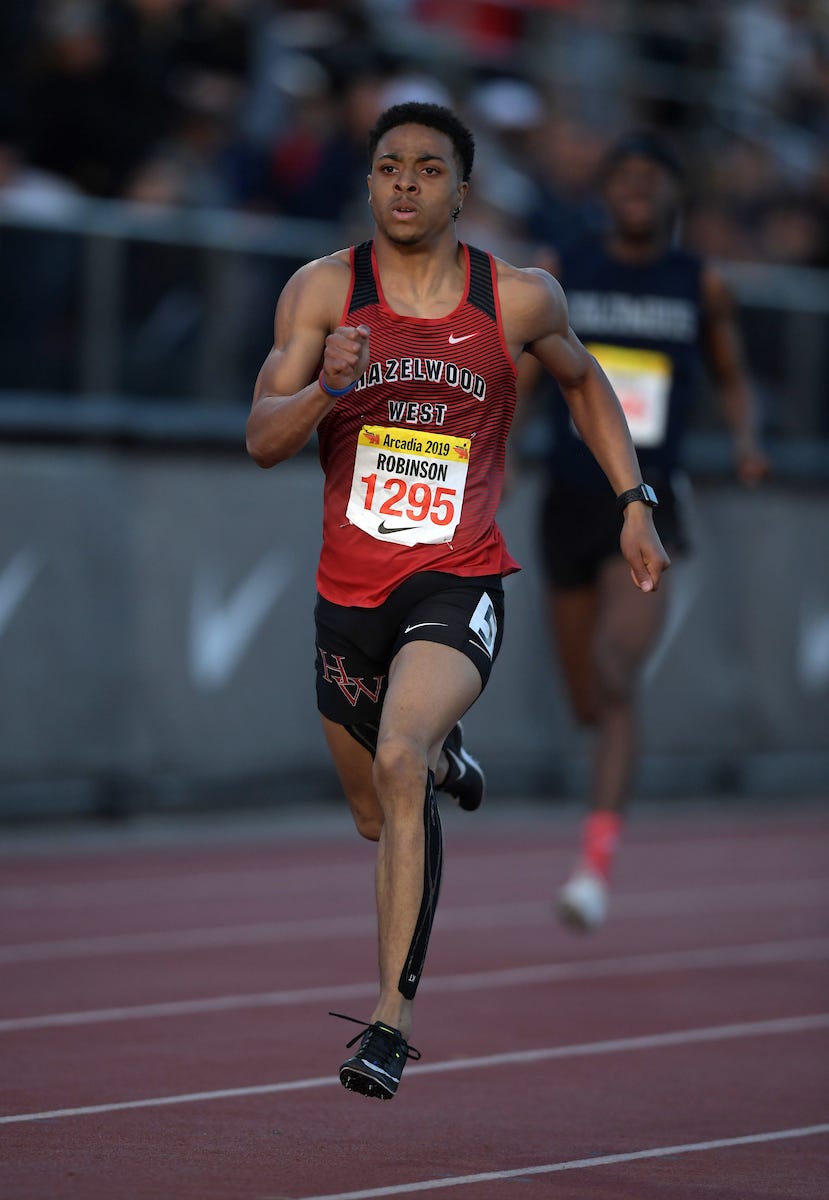Former Missouri prep star now a 400 contender at Arizona State
Sophomore sprinter Justin Robinson rebounds from disruption, disappointment

Ask sprinter Justin Robinson of Arizona State University who has been his biggest influence, and he will quickly tell you it is his mom — for working so hard as a single parent to raise him and his older sister Tamisha.
“That motivated me to always work hard and to never, never give up,” he said.
The determination has served Robinson well, as he is expected to contend for the men’s 400-meter title when the NCAA Indoor Track and Field Championships begin on Friday at the Albuquerque Convention Center in New Mexico.
Like numerous entrants, Robinson competed at the Albuquerque Convention Center earlier this season. But he will be the lone competitor in the collegiate meet who won an individual title in the USA Track & Field Indoor Championships — going up against professionals — at the same facility last month.
Arizona State belongs to the Pacific 12 Conference, which does not contest an indoor conference championship event, so Robinson used the USATF meet as one. He ran a then-indoor personal best of 45.48 seconds to finish second in his qualifying heat on Feb. 17 before bettering that time in the following day’s final. His 45.40 clocking left him clear of Noah Williams (45.69), Craig Allen (46.11), 2022 World indoor silver medalist Trevor Bassitt (46.13), and Brycen Spratling (46.34).
He knows the NCAA meet will have a significantly deeper field than the USATF Championships, but “winning a national title is a huge accomplishment and it gave me a lot of confidence,” he said. “It just solidified some things that I had been working on and let me know that OK, I’m back. I’m good. I can still go out there and compete. I’m still who I am.”
Robinson, a Kinesiology major, is a 20-year-old sophomore who had a stellar high school career before the COVID-19 pandemic brought the world to a standstill in 2020. He set a world U18 (under 18) record of 44.84 in the 400 in the 2019 Great Southwest Classic at the University of New Mexico in Albuquerque a week after completing his junior year at Hazelwood (Missouri) West High School.
That effort, which still ranks as the second-fastest 400 ever run by a prep athlete in the U.S., was the start of a phenomenal summer for Robinson that included gold medals in the 400 meters and in the 1,600 relay in the Pan American U20 Athletics Championships in San Jose, Costa Rica, in July, and a bronze medal in the 400 and a silver medal in the 1,600 relay in the Pan American Games in Lima, Peru in August.
Robinson’s winning time of 45.04 in the Pan Am U20 Championships came after he had won his qualifying heat in 45.96. Two days later he teamed up with Frederick Lewis, Matthew Boling, and Matthew Moorer to win the 1,600 relay in a world U20 record of 2:59.30 in a race in which he was credited with a stunning 43.54-second split on his anchor leg.
Three weeks after that the 17-year-old Robinson ran 45.07 in the final of the Pan American Games – after a 45.38 clocking in a heat – while finishing third to 21-year-old Anthony Zambrano of Colombia (44.83) and 26-year-old Demish Gaye of Jamaica (44.94), who later placed second and fourth in the World Athletics Championships in Doha, Qatar in October.
Not bad for someone who played football growing up and did not start running track until his freshman year of high school.
“I knew nothing about track when I first started,” said Robinson, who recorded bests of 48.03 in the 400 as a freshman and 46.20 as a sophomore. “I really didn’t know how fast I was until my junior year and then I started to take things seriously and I started looking at other people’s times and the progression that other athletes were making … Before that, I was just out there running.”
Robinson, who will also run in the 1,600 relay in the NCAA meet, feels very fortunate to have come under the guidance of assistant coach Sean Burris during his first year at Hazelwood West because Burris saw his potential in the 400. Perhaps just as importantly, Robinson didn’t know that most aspiring sprinters preferred to run the 100 and 200 over the 400.
“The 400 is really a very blue-collar event,” said Burris, who started coaching at the high school level in 1996. “Going into it, you know it’s not going to be fun and it’s going to hurt.”
Although Burris said Robinson ran “54-something” in his first 400 as a freshman, he was not discouraged. Burris added that “he worked for every tenth of a second he got that year.”

It was during the summer in between Robinson’s sophomore and junior year that Burris did something he had never done with any of the athletes he coached. He encouraged Robinson to stop playing football so he could focus on track year-round.
“I had coached plenty of multi-sport athletes before and I did not have a problem with them competing in different sports,” Burris said. “But Justin was special. I just wanted to be very clear with him about what was possible and what was at stake.”
Robinson, who still recalls the discussion he had with Burris at a fast food eatery, understood that he was a better quarter-miler in track than he was a wide receiver in football. But dropping a sport he had played since he was a little kid was not easy and he said it was difficult to “give up on guys I had been playing with every summer and fall since I was 6.”
The decision became easier to accept during the spring of his junior track season when he ran 46.22 to win the prestigious Arcadia Invitational in southern California in early April and then led Hazelwood West to its first state Class 5 title in May by winning the 100, 200, and 400, and running the anchor leg on the victorious 800 relay team.
Burris was initially opposed to Robinson running so many races in the state meet as he was worried that such an effort might prevent him from having fresh legs for the Pan American meets that summer. But he said Robinson was adamant about helping his team win a championship.
That determination was put to a test when a series of tornadoes in Missouri damaged several schools and led to the state divisional finals being held at separate sites – instead of one location – and over one day instead of two days.
The end result was that Robinson ran heats of the 100 (10.79) and 200 (22.03), before winning the 100 final in 10.56, anchoring the 4x200 relay to victory in 1:26.44, and placing first in the finals of the 400 (46.30) and 200 (21.96) over a time span of about four and a half hours.
Burris said Robinson was exhausted when he got into the starting blocks for the final of the 200, but he managed to win the race as Hazelwood West totaled 66 points to the 49 of runner-up Lee’s Summit North.
After having such a tremendous junior season, Robinson and Burris were looking forward to what they both described as a “breakout” senior year in 2020.
With the rapid improvement he made as a junior, Robinson felt that he had a shot to make the U.S. team that was scheduled to compete in the Olympic Games in Tokyo in the summer of 2020, but then the COVID-19 pandemic hit and the Games were postponed for a year and high schools in Missouri – as in so many states – shut down for the remainder of the spring semester.
Nonetheless, Robinson found ways to continue to train under the direction of Burris and in August – during a brief compacted outdoor season in the U.S. – he ran 44.91 in a meet in Marietta, Georgia to win a race that included world-class performers Michael Cherry of the U.S. (44.98) and Matthew Hudson-Smith of Great Britain (45.58).
The time, which came in Robinson’s only race of the season, was the second-fastest of his career and ended up being the fastest time in the world that year.
With the U.S. Olympic Trials being postponed until June of 2021, Robinson had decided earlier in the year to take a gap year in between high school and starting classes at Arizona State.
A desire to continue to train with Burris through the 2021 Olympic season played a part in his decision, but his mom and dad were also very concerned about the COVID-19 infection rates in Arizona that were amongst the highest in the nation.

Although his preparations for the Olympic Trials went very well – he placed second in 45.00 in a meet in Jacksonville at the end of May – he became ill shortly after arriving in Eugene, Oregon for the Trials, and was eliminated in the semifinals when his 45.41 clocking was .29 seconds shy of the 45.12 time that made Vernon Norwood the last qualifier for the final.
“We knew he was in great shape,” Burris said. “But when he got to the point in [his semifinal] where he usually would make a move, he just couldn’t go.”
Robinson said he “wanted to make that team with every bone in my body. But given the circumstances … just going out there and competing and getting that far was a huge accomplishment. Obviously, I wanted to be in the final and make the team and go to Tokyo with those guys. But sometimes you fall short and the reasons I don’t know. It’s all up to God so I just kept trusting in him and took my path a different way.”
As planned, Robinson’s path took him to Arizona State for his freshman year during the 2021-22 academic year. But he didn’t get the results he had hoped for.
His indoor personal best of 46.06 left him just shy of grabbing one of the 16 semifinal spots for the NCAA Championships, and though he ran 45.30 outdoors, he did not advance to the final of the NCAA meet after placing fifth in his semifinal with a time of 46.23.
Dion Miller, the director of cross country and track & field at Arizona State, said Robinson had a “really good first year,” adding that there’s “always an adjustment period when an athlete goes from high school to college.”
He also noted that in addition to lowering his personal best in the 400 indoors, Robinson produced career bests in the indoor 60 (6.77) and 200 (20.81), and in the 100 (10.49) and 200 (20.52) outdoors.
However, Robinson’s view was not as rosy as that of his coach. His inability to advance to the finals of the NCAA Championships in the 400 left him in a reflective state of mind, and he asked himself if he should stay at ASU or transfer to another school? And as he puts it, “Was I any good anymore?”
He ultimately decided that Arizona State was the right place for him, and says there is now more give and take between him and Miller when it comes to things such as training, recovery, and races.
For his part, Miller says he and Robinson “both have kindred spirits” when it comes to where they want to go in the 400.
“He’s put himself in great position heading into the [NCAA Championships],” Miller said. “His training has gone well and he has put in the work that he needed to put himself in a position to be successful.”

The 5-foot-9, 158-pound Robinson is also getting more comfortable and confident about running the 400 indoors.
As he says, “The 400 is a beast, but running the 400 indoors is a different beast in itself.”
He points out that running the 400 indoors on a 200-meter track requires you to negotiate four turns instead of two like you do outdoors on a flat 400-meter oval. In addition, an indoor 400 consists of competitors running in separate lanes for the first two turns of the race before breaking for the inside lane for the second lap. He also equates coming into and out of the banked turns of an indoor track with running uphill or downhill.
“Every race is a learning opportunity,” he said. “Win, lose, or draw, I just take bits and pieces from each race and try to use them to help me in future races.”
He learned a lot from a disappointing outcome in the Razorback Invitational at the University of Arkansas on Jan. 28 when he finished fourth in his heat in 48.53 after leading the race for the first lap.
The first mistake he made came when he drifted toward the outside of the first lane coming out of the third turn. That allowed Christopher Bailey of Arkansas to race past him on the inside of lane one, and Robinson compounded matters by trying to immediately – instead of gradually – catch Bailey, which threw off his rhythm. Finally, he got tangled up with the University of Florida’s Emmanuel Bamidele entering the home straightaway and nearly fell off the inside of the track while losing whatever momentum he had left in a contest in which Bailey ran a then-yearly world leading time of 45.09.
“The whole race was just a learning experience,” Robinson said. “After that, I started clicking and putting stuff together and figuring out how to approach the race a little bit better.”
That was evident in the final of the USATF Indoor Championships when he went from third place to first on the last lap after his opening 200 of 21.42 left him well back of defending champion Bassitt (20.88) and Noah Williams (21.04).
“I was like, Either I’m going way too slow or they’re going way too fast,” Robinson said of the first lap. “As it turned out they were going a little bit too fast … I started seeing I was within striking distance of them and I could see their bodies breaking down and their facial expressions as well.”
After feeling “nowhere near as tired as I should have coming down the backstretch the second time,” Robinson came off the final curve remembering what Burris always told him about keeping his chin down and hammering off the curve at the end of a 400.
That helped propel him past the front-running Williams and gave him a margin of victory of nearly three tenths of a second.
Robinson’s mom, Shermika Ward, was happy about her son’s win for she knew how much it meant to him and how hard he has worked to get to where he is. She is also proud of him for keeping his head up in recent seasons when things have not always gone his way.
“He just kept moving forward,” she said of her son, who she describes as a respectful, caring, and resilient person who loves his family. “He’s never showed any frustration. He’s never showed any signs of giving up.”
He now has a chance to fulfill his top preseason goal of advancing to the NCAA finals and going toe-to-toe with elite competitors such as Elija Godwin of Georgia, Bailey, and Ryan Willie of Florida, who currently stand first, third, and fourth on the yearly world performer list with bests of 44.75, 45.09, and 45.15, respectively.
“When he gets to the NCAA meet, he’s going to be one of the most experienced guys in the field,” Burris said of Robinson. “He’s just got to bring that experience into the meet and put it to good use. He’s in the perfect position.”
Robinson is stoked about the opportunity to compete for his second national title in the last three weeks.
“It just makes me so excited,” he said. “Just knowing that it’s going to be a good race and it’s going to be great to see everybody on the track. I’m excited to see what these guys can do and I’m excited to see what I can do against them.”



